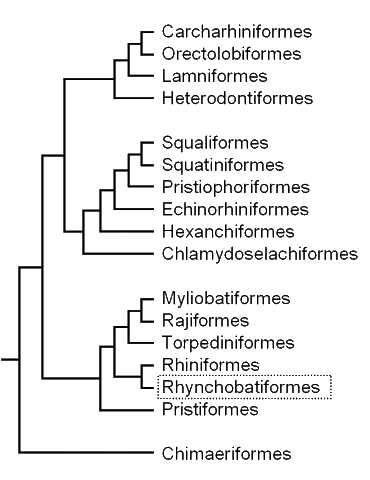Batoids: Order Rhynchobatiformes:
Shovelnose Guitarfishes — 44 species

- snout pointed
- dorsal fins shark-like, located over or behind posterior part of pectoral fins
- caudal fin with strong or weak lower lobe
- ovoviviparous
- occur in temperate to tropical zones of Atlantic, Pacific, and Indian oceans; common near continental coastlines but rare near oceanic islands; mostly marine, but several species occur in estuaries and even freshwater
- 5 genera in 2 families
The largest guitarfishes reach a length of 6.5 feet (2 metres), and have litters of up to 29 pups. The Atlantic Guitarfish (Rhinobatos lentiginosus), which ranges from North Carolina to southern Mexico, is one of the smaller species, reaching only 2.5 feet (75 centimetres) in length. This species typically bears only six pups, each about 8 inches (20 centimetres) long.
|
|
The Shovelnose Guitarfish (Rhinobatos productus), which grows to a length of about 5.5 feet (1.7 metres), ranges from the intertidal down to a depth of 43 feet (13 metres) and is commonly encountered by divers from central California to the Sea of Cortez. There is one authenticated case of a Shovelnose biting a diver, who apparently interrupted a male guiterfish in mid-courtship. The diver was probably not in serious danger, for guitarfishes have pavement-like teeth that can — at worst — result in a thorough 'gumming' of anything larger than their normal prey of worms, clams, crabs, and small fishes. Shovelnose mating takes place between April and May, resulting in as many as 28, 6-inch (15-centimetre) pups. The Whitespotted Guitarfish (Rhynchobatus djiddensis), which grows to a length of over 10 feet (3 metres), is widely distributed in the tropical Indo-west Pacific. It is among the most sought-after elasmobranchs for sharkfin soup and, consequently, there are concerns about overfishing.
There are five genera of shovelnose guitarfishes in perhaps two families (Rhynchobatidae, containing Rhynchobatus, and Rhinobatidae, containing Rhinobatos, Aptychotrema, Zapteryx, and Trygonorrhina). Some workers place Rhynchobatus with Rhina (from the previous order, Rhiniformes) in a single family — either Rhinidae or Rhynchobatidae. The taxonomy of this group — especially those genera constituting the Rhinobatidae — is highly uncertain and in need of further work to clarify interrelationships.

